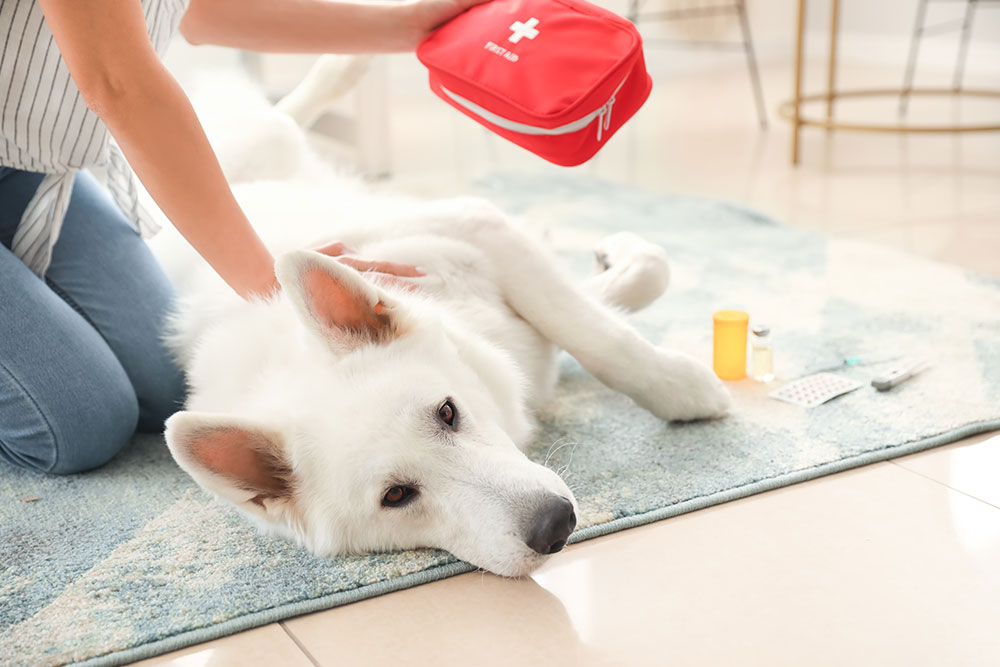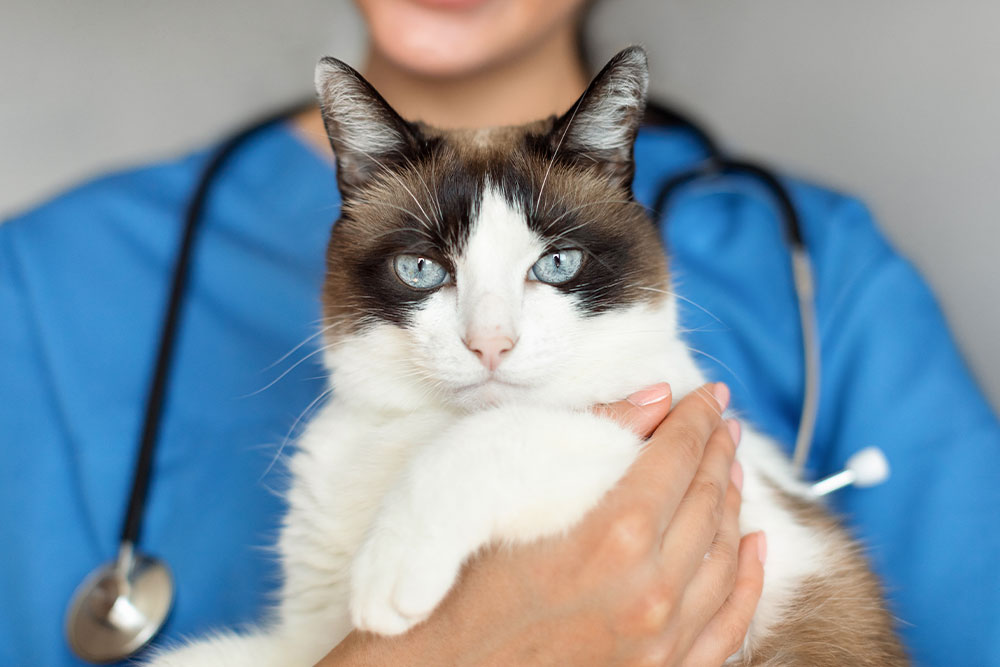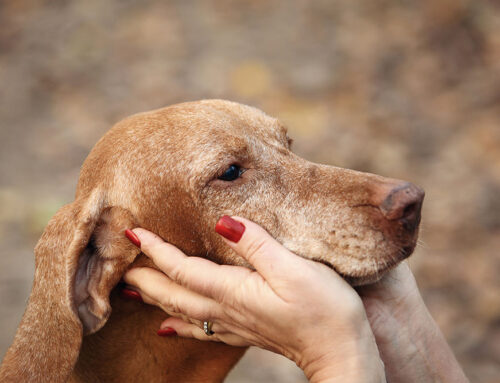Pet First Aid Basics: What to Know, When to Act, and How to Prepare
Emergencies can happen to any pet, at any time. Whether your dog tears a toenail, your cat injures a paw, or your puppy chokes on a toy, knowing basic first aid can make all the difference. But just as important as learning what to do is knowing when first aid is enough and when it’s time to get your pet to a veterinarian. Pet owners who prepare ahead of time are calmer, more effective, and better able to protect their pets in stressful situations.
At Central Kentucky Veterinary Center in Georgetown, we provide comprehensive care for dogs, cats, and exotic pets. As an AAHA accredited hospital with extended evening and weekend hours, our team is here when you need us most- including during urgent and emergency situations.
How to Recognize a Pet Emergency
The first step in pet first aid is recognizing when something is serious. A small scratch or broken toenail may be managed at home, but heavy bleeding, difficulty breathing, or loss of consciousness should never wait. If you are unsure, it’s always safest to head to the veterinary hospital right away.
For less urgent concerns, a DIY Dog Checkup can help you notice small problems before they become big ones. Routine checks of your pet’s skin, paws, mouth, and eyes help you spot issues early.
First Aid vs. Veterinary Care: Knowing the Limits
First aid is about stabilizing your pet until professional care is available. It is not a substitute for a veterinarian’s diagnosis or treatment. For example, you can apply pressure to stop bleeding from a wound at home, but your vet may need to clean it properly, stitch it closed, or prescribe antibiotics. If your pet ingests something toxic, you can call poison control for advice, but only a veterinarian can administer the antidote or provide hospitalization if needed.
At Central Kentucky Veterinary Center, our services include emergency care, advanced surgery, imaging, and rehabilitation therapies, ensuring we’re prepared to handle everything from sudden injuries to life-threatening conditions. If you aren’t sure- just call us.
When First Aid at Home Is Okay
Not every injury means a trip to the emergency clinic. Just like kids scrape their knees at the playground, pets often come home from the dog park or backyard with minor bumps and bruises. Good examples of situations where at-home first aid is usually enough include:
- A small scrape that isn’t bleeding or infected
- A superficial paw pad tear from running on rocks
- A thorn or small splinter you can gently remove
- A cracked toenail that isn’t exposing the sensitive quick
- A shallow cat scratch on the nose from being a little too curious
For these types of minor issues, cleaning the area with mild soap and water is often sufficient. Preventing licking with a cone and monitoring the area for redness, swelling, or discharge are key steps. If the wound worsens, becomes painful, or starts to ooze pus, then it’s time for veterinary attention.
Common Pet Emergencies and What You Can Do
Choking
Choking is one of the most frightening emergencies. Toys that are too small or chews swallowed whole are common culprits. If your dog is gagging, pawing at their mouth, or unable to breathe, you may need to act quickly. These dog Heimlich instructions explain how to try to safely dislodge an object. Even if you’re able to clear the airway, your pet should still see a veterinarian afterward to ensure no damage occurred.
Poisoning
Common toxins include chocolate, grapes, xylitol, medications, and certain plants. If you suspect your pet has eaten something dangerous, call Pet Poison Control immediately. They can guide you on whether to go straight to the vet or take steps at home. Never induce vomiting unless a professional instructs you to do so.
CPR and Breathing Emergencies
If your pet collapses and is not breathing, knowing CPR can save your pet’s life. However, CPR should always be followed by immediate veterinary care, even if your pet seems to recover.
Wounds and Injuries
Pets are active and curious, which means injuries are bound to happen. Here’s how to know what you can manage at home and what requires immediate veterinary care:
- Okay for at-home first aid: Minor cuts or scrapes that are not bleeding heavily, not deep, and not infected. Clean with mild soap and water, protect with a cone, and monitor closely.
- Always see the vet:
- Bite wounds: they may look small on the outside but often trap bacteria deep inside. It’s rarely as simple as a small puncture, since pets bite and pull or shake – causing deeper tissue damage.
- Trauma: If your pet is hit by a car, falls from a height, or has any sort of event that makes your heart stop wondering if they’ll be ok- see the vet. Trauma often comes with an adrenaline rush and cortisol release, meaning your pet is more easily able to hide symptoms of internal injuries.
- Lacerations: especially if bleeding won’t stop, it’s more than one inch in length, or the wound edges are gaping.
- Broken bones: splinting can help with stabilization, but pets need x-rays and pain management.
- Burns: heat, chemical, or electrical burns always require fast medical care.
- Broken nails with an exposed quick: while not an emergency, painful and bleeding nails are prone to infection.
- Eye injuries, broken teeth, or wounds near the chest and abdomen should never be treated at home.
The safest rule: if you’re not sure, let a veterinarian decide. With extended hours and a highly trained team, Central Kentucky Veterinary Center is available to evaluate and treat your pet when emergencies arise.
On the Way to the Vet: Keeping Your Pet and Yourself Safe
When a pet is injured, frightened, or in pain, even the gentlest animal may bite. Keeping both your pet and yourself safe is just as important as stabilizing the injury.
If your pet is licking or scratching a wound, a cone for your pet can prevent further damage. Broken limbs should be gently supported, but avoid manipulating them too much. For smaller pets, use a carrier or crate to reduce stress and movement. For larger animals, a sturdy towel, blanket, or improvised stretcher can help you lift and transport them safely.
In some cases, using a soft muzzle is the kindest option. This prevents an injured pet from biting while you are helping them. Always keep calm, handle your pet gently, and remember your goal is not to treat the injury on your own but to get your pet safely into professional hands.
Preparing Before an Emergency Happens
Take a Class
Preparation is best done before a crisis. A pet first aid class can teach you hands-on skills for handling emergencies confidently.
Review Emergency Situations
Know what an emergency looks like, before you’re in the middle of one. Be familiar with the signs of a crisis so you can act quickly.
Train Cooperative Care
Handling an injured pet is easier if they are used to gentle restraint and touch. Practicing cooperative care makes nail trims, wound cleaning, and even emergency transport less stressful. Cooperative care teaches your pet they can trust you, even when you’re doing something they aren’t thrilled about.
Build a First Aid Kit and Plan
Every pet household should have a basic first aid kit with bandages, antiseptic wipes, saline solution, tweezers, a cone, and a muzzle. Keep your veterinarian’s phone number and the nearest emergency clinic handy. Financial preparedness is also important – a pet savings account and pet insurance can help cover the unexpected costs of emergency care.
At Central Kentucky Veterinary Center, our compassionate team is AAHA-accredited and highly trained in emergency care. We combine advanced diagnostics, surgical expertise, and a focus on quality of life to provide gold-standard treatment when your pet needs it most.
Be Prepared, Stay Calm, Act Quickly
Pet first aid is about buying time and preventing complications until professional help is available. By learning the basics, knowing the limits of what you can do at home, and preparing in advance, you’ll be ready to protect your pet when the unexpected happens.
If your pet experiences an emergency, our team at Central Kentucky Veterinary Center is here to help. We proudly serve dogs, cats, and exotics with extended evening and weekend hours to fit your family’s needs. To learn more, request an appointment, contact us, or call (502) 863-0868.








Leave A Comment